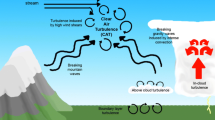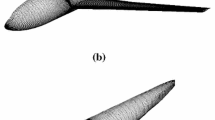Summary
In this paper, we will focus on the real-time prediction of environments that are predisposed to producing moderate-severe (hazardous) aviation turbulence. We will describe the numerical model and its postprocessing system that is designed for said prediction of environments predisposed to severe aviation turbulence as well as presenting numerous examples of its utility. The purpose of this paper is to demonstrate that simple hydrostatic precursor circulations organize regions of preferred wave breaking and turbulence at the nonhydrostatic scales of motion. This will be demonstrated with a hydrostatic numerical modeling system, which can be run in real time on a very inexpensive university computer workstation employing simple forecast indices. The forecast system is designed to efficiently support forecasters who are directing research aircraft to measure the environment immediately surrounding turbulence.
The numerical model is MASS version 5.13, which is integrated over three different grid matrices in real-time on a university workstation in support of NASA-Langley’s B-757 turbulence research flight missions. The model horizontal resolutions are 60, 30, and 15 km and the grids are centered over the region of operational NASA-Langley B-757 turbulence flight missions.
The postprocessing system includes several turbulence-related products including four turbulence forecasting indices, winds, streamlines, turbulence kinetic energy, and Richardson numbers. Additionally there are convective products including precipitation, cloud height, cloud mass fluxes, lifted index, and K-index. Furthermore, soundings, sounding parameters, and Froude number plots are also provided. The horizontal cross section plot products are provided from 16,000–46,000 feet in 2,000 feet intervals. Products are available every three hours at the 60 and 30 km grid interval and every 1.5 hours at the 15 km grid interval. The model is initialized from the NWS ETA analyses and integrated two times a day.
Similar content being viewed by others
References
GP Ellrod DI Knapp (1992) ArticleTitleAn objective clear air turbulence forecasting technique: verification and operational use Wea Forecast 7 150–165 Occurrence Handle10.1175/1520-0434(1992)007<0150:AOCATF>2.0.CO;2
JS Kain JM Fritsch (1990) ArticleTitleA one-dimensional entraining-detraining plume model J Atmos Sci 47 2784–2802 Occurrence Handle10.1175/1520-0469(1990)047<2784:AODEPM>2.0.CO;2
ML Kaplan Y-L Lin JJ Charney KD Pfeiffer DB Ensley DS DeCroix RP Weglarz (2000) ArticleTitleA terminal area PBL prediction system at Dallas–Fort Worth and its application in simulating diurnal PBL jets Bull Amer Meteor Soc 81 2179–2204 Occurrence Handle10.1175/1520-0477(2000)081<2179:ATAPPS>2.3.CO;2
Kaplan ML, Lux KM, Cetola JD, Huffman AW, Riordan AJ, Slusser SW, Lin YL, Charney JJ, Waight KT III (2004) Characterizing the severe turbulence environments associated with commercial aviation accidents. A Real-Time Turbulence Model (RTTM) designed for the operational prediction of hazardous aviation turbulence environments. NASA/CR-2004-213025, NASA Langley Research Center, August 2004, 54 pp
ML Kaplan AW Huffman KM Lux JD Cetola JJ Charney AJ Riordan Y-L Lin KT Waight SuffixIII (2005a) ArticleTitleCharacterizing the severe turbulence environments associated with commercial aviation accidents. A 44 case study synoptic observational analyses Meteorol Atmos Phys 88 129–152 Occurrence Handle10.1007/s00703-004-0080-0
ML Kaplan AW Huffman KM Lux JD Cetola JJ Charney AJ Riordan Y-L Lin KT Waight SuffixIII (2005b) ArticleTitleCharacterizing the severe turbulence environments associated with commercial aviation accidents. Hydrostatic mesoscale numerical simulations of supergradient wind flow and ageostrophic along-stream frontogenesis Meteorol Atmos Phys 88 153–173 Occurrence Handle10.1007/s00703-004-0079-6
JA Knox (1997) ArticleTitlePossible mechanisms of clear air turbulence in strongly anticyclonic flows Mon Wea Rev 125 1251–1259 Occurrence Handle10.1175/1520-0493(1997)125<1251:PMOCAT>2.0.CO;2
Marroquin A (1998) An advanced algorithm to diagnose atmospheric turbulence using numerical model output. Preprints, 16th Conf. on Weather Analysis and Forecasting, 11–16 January, 1998 Phoenix, AZ, pp 79–81
Proctor FH (2000) Personal communication
Sharman R, Wiener G, Brown B (2000) Description and verification of the NCAR Integrated Turbulence Forecasting Algorithm (ITFA). AIAA 00-0493. AIAA 38th Aerospace Sciences Meeting and Exhibit, 10–13 January, 2000-AIAA, Reno, NV
PH Stone (1966) ArticleTitleOn non-geostrophic baroclinic instability J Atmos Sci 23 390–400 Occurrence Handle10.1175/1520-0469(1966)023<0390:ONGBS>2.0.CO;2
Author information
Authors and Affiliations
Rights and permissions
About this article
Cite this article
Kaplan, M., Charney, J., Waight, K. et al. Characterizing the severe turbulence environments associated with commercial aviation accidents. A real-time turbulence model (RTTM) designed for the operational prediction of hazardous aviation turbulence environments. Meteorol. Atmos. Phys. 94, 235–270 (2006). https://doi.org/10.1007/s00703-005-0181-4
Received:
Revised:
Accepted:
Published:
Issue Date:
DOI: https://doi.org/10.1007/s00703-005-0181-4




